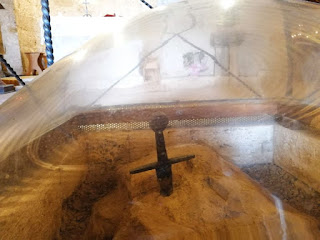Not long after this vision, while he was out riding, his horse refused his commands and led him to the hill of Montesiepi. He recognized it as the hill in his vision, drew his sword, and thrust it at the ground; it sank into the stone just like in his vision. He became a hermit on the spot. He died a year later.
A chapel was built over the site of his death, drawing pilgrims and penitents. Miracles were reported after praying to him, and in 1185 Pope Lucius III canonized him according to the new form al rules of the Catholic Church. A Cistercian Abbey of San Galgano was begun around 1220. The Abbey struggled financially, and was ransacked by John Hawkwood's band in 1363. It is in ruins now.
The sword in the stone, however, exists. Nearby, at the Rotonda of Montesiepi, there is a chapel with it on display (see the illustration). Research in 2001 showed that the metal protruding from the stone was consistent with the style of the 12th century. The handle and visible blade do not seem to be a prop merely attached to the stone. It really does seem to be a real sword embedded in a stone.
Hmm. Sword in a stone. Where have I heard that image before? We should look into that.

